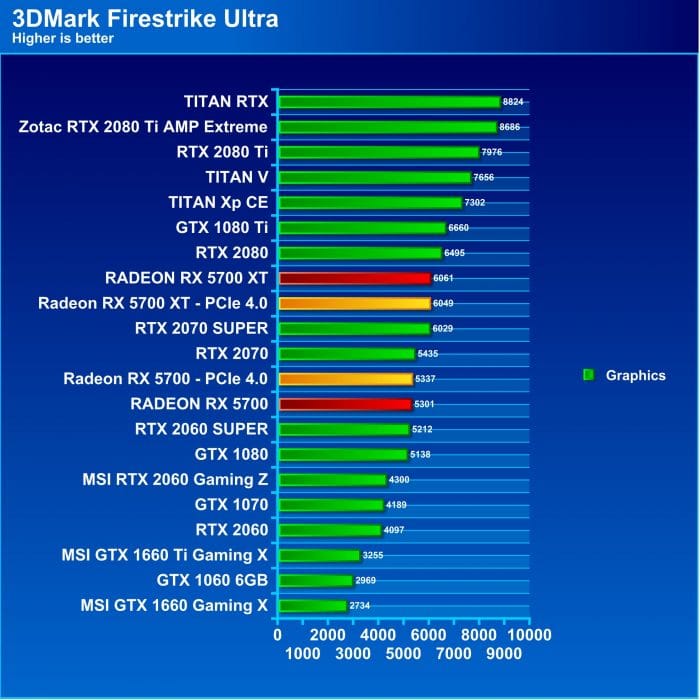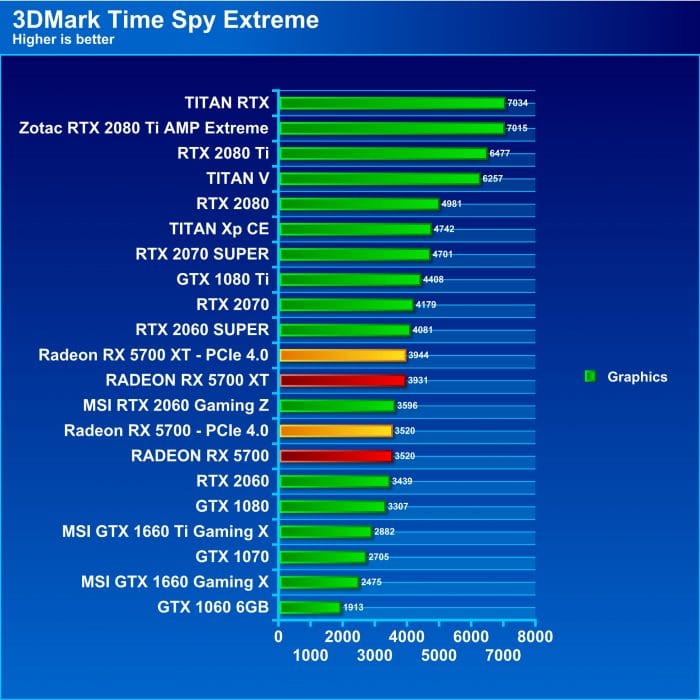Does PCIe 4.0 help the RX 5700 series?
Here We will test a few of our benchmark suite to see if there is any real difference in performance being on the new PXIe 4.0 X570 Platform.
| Test Rig |
|
| Case Type | Praxis Wet Bench |
| CPU | AMD Radeon 7 3700X (8C/16T) |
| Motherboard | ASUS Crosshair VIII Hero WiFi |
| RAM | 16GB (2x8GB) GSKILL Royal RGB 3600MHz C16 (Amazon) |
| CPU Cooler | Thermaltake Floe Riing 360 (Amazon) |
| Hard Drives | Samsung 960 EVO 512GB M.2 2280 NVMe (Amazon)
Samsung 860 EVO 4TB SATA (Amazon) |
| Optical | LG BD-RW BH16NS40 |
| GPU | Radeon RX 5700 XT
Radeon RX 5700 Nvidia TITAN RTX Nvidia GeForce RTX 2080 Ti Founders Edition Nvidia GeForce RTX 2080 Founders Edition Nvidia GeForce RTX 2070 SUPER Nvidia GeForce RTX 2070 Founders Edition Nvidia GeForce RTX 2060 SUPER Nvidia GeForce RTX 2060 Founders Edition Nvidia GeForce GTX 1660 Ti Nvidia GeForce GTX 1660 Nvidia TITAN V Nvidia TITAN Xp Collectors Edition (Galactic Empire) Nvidia GeForce GTX 1080 Ti Founders Edition Nvidia GeForce GTX 1080 Founders Edition Nvidia GeForce GTX 1070 Sounders Edition Nvidia GeForce GTX 1060 6GB |
| Monitor | ASUS PG27AQ 4K 60Hz GSYNC (Amazon) |
| Case Fans | 1 x 140mm Mosfet / CPU / RAM cooling fan 1 x 140mm PCI-E Cooling Fan |
| Docking Stations | None |
| Testing PSU | Thermaltake XT 1475W Gold (Amazon) |
| Legacy | None |
| Mouse | Logitech G502 (Amazon) |
| Keyboard | Logitech Pro eSPORTS Keyboard (Amazon) |
Note – we received a commission on any purchases made via any Amazon-link here.
Shadow Of The Tomb Raider

Now we’re getting into the territory of a game more optimized for the higher performance GPUs. Shadow of the Tomb Raider is an awesome game and part of a long lasting franchise. It supports full DX12 along with new RTX features which we may start to include in testing once Radeon options have ray tracing capabilities enabled. We run at max details at DX12 with RTX and DLSS disabled.
First up is an actual game. Shadow of the Tomb Raider shows that any graphical performance swapping to PCIe 4.0 is within the margin for error at best. This tells me something that I suspected which is that the GPUs simply do not have enough bandwidth needs to show any performance gains at least at this time. I’m sure we will get there but time will tell as tech evolves.
3DMark Fire strike

3DMark Firestrike Ultra shows a gain for the RX 5700 while the RX 5700 XT actually lost some steam at PCIe 4.0. I can only assume this is standard testing variance at play and once again call it more proof in the pudding.
3DMark Time Spy

Time Spy Extreme is more of the same. The RX 5700 shows no change at all, with the exact same graphics score. The RX 5700 XT shows an extremely minor gain and within a close enough margin that I would not call it a reason to need PCIe 4.0 for these cards.
The numbers don’t lie, while it’s cool to have PCIe 4.0 on the platform, it simply will not net you much as far as GPU performance gains. SSD/Storage and other devices such as network and HBAs I could see a major advantage to the new interface. But You would be safe to grab an RX 5700 series for any of your current PCIe 3.0 based platforms and you will not suffer any measurable performance loss.
 Bjorn3D.com Bjorn3d.com – Satisfying Your Daily Tech Cravings Since 1996
Bjorn3D.com Bjorn3d.com – Satisfying Your Daily Tech Cravings Since 1996












Hot and loud and performance is ok but not great.
It was truly not very hot or loud in my experience. I have seen some who have reported that issue but my card under gaming loading never got anywhere above expected GPU temps. I do wish it had more headroom, but we will find out as WATTMAN was still pretty sketchy when we got a last-minute driver to test it.